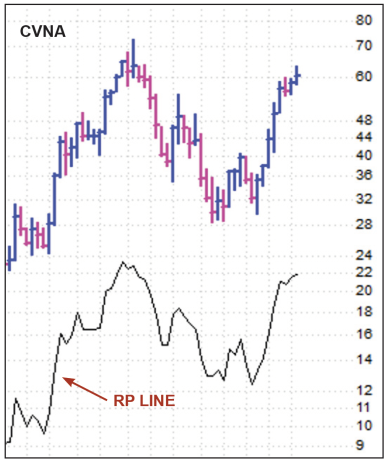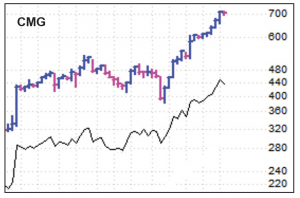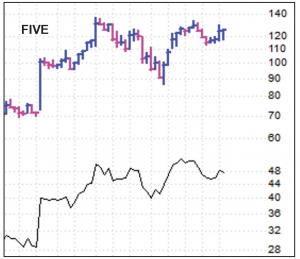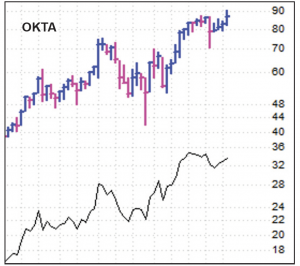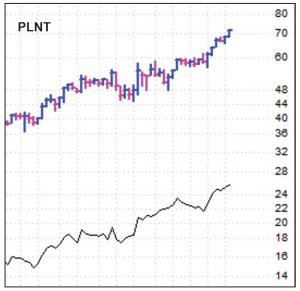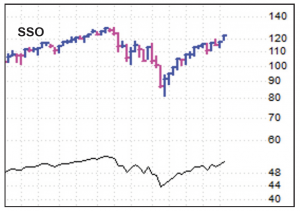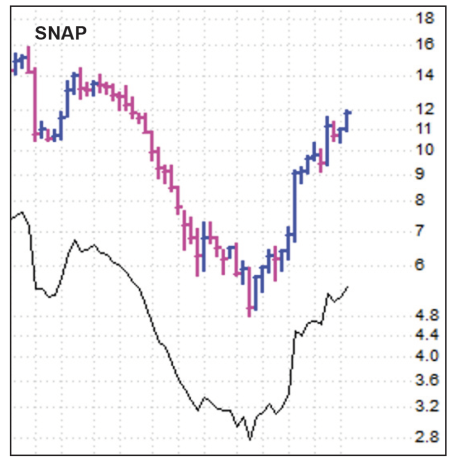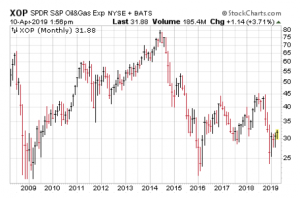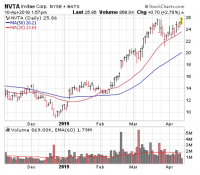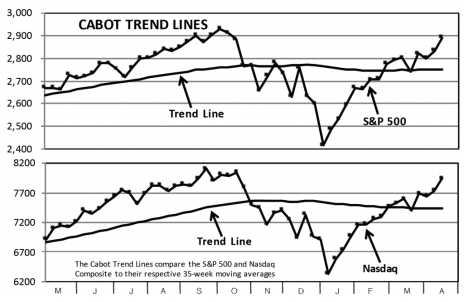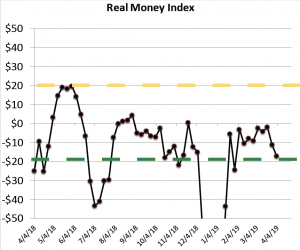The past few weeks have been choppy and challenging for many growth stocks, but we’re happy to see some of the yellow flags from last week be addressed--our Cabot Tides, which were on the fence, are again positive, and most growth stocks that dipped to support have found buyers. Of course, there remain some worries (earnings season is coming up; relatively few stocks are hitting new highs), but most of the evidence remains bullish
Tonight, in fact, we’re putting some of our sidelined cash back to work by averaging up in one stock and starting with a half-sized position in another, which will leave us with 17% cash.
In tonight’s Cabot Growth Investor, we talk about all our current holdings, highlight one beaten-down sector we’re keeping a distant eye on for a new upturn, as well as look at some little-known names that are on our watch list.
Cabot Growth Investor 1417
[premium_html_toc post_id="174956"]
The Perfect Isn’t the Enemy of the Good
One reason the market is such an interesting place is that there are always differing opinions even among the smartest and most thorough investors. The late Martin Zweig once said that, if you had 100 market indicators, it would be very rare for 80 of them to lean in just one direction—even in strong uptrends, for instance, there will be plenty of bearish factors to keep investors off balance.
We’ve certainly seen that during the past month and a half, with some sloppy action from the broad market (lagging small- and mid-cap indexes and fewer stocks hitting new highs), some sharp selloffs in growth stocks and, as of two weeks ago, an intermediate-term trend that was on the fence.
Was the environment perfect? Nope. But that’s OK—the perfect isn’t the enemy of the good. While there were yellow flags to keep an eye on and reasons to ease off the gas pedal a bit (we got knocked out of two stocks and held off most new buying), the majority of the evidence remained positive, so we remained mostly invested.
And now we’re seeing some of the recent yellow flags disappear! During the past few days, small- and mid-cap indexes have kicked into gear, helping our Cabot Tides return to positive territory. And, more important, many growth stocks that tested key support during last week’s wobbles have held up, with a few snapping back to new highs (like OKTA) and some others that look ready to break out after multi-week rests (like WDAY).
Of course, there are still some things to worry about. Earnings season is about to get underway, and we all know the volatility that brings. Some sentiment measures (put-call ratios) are showing complacency. And we’re still not seeing that many stocks hit new highs.
But, while not perfect, the evidence remains very good—the big-picture outlook still points toward us being in the early stages of a new bull phase, and near term, we’re beginning to see buying power return.
[highlight_box]WHAT TO DO NOW: Because of our two recent sales, we had built up 27% in cash, but tonight we’ll put a chunk back to work by adding two half-sized positions—one in Okta, filling out our stake, and another in Carvana (CVNA), which we think has great potential. We’re also placing Five Below back on Buy. Our cash position will now be around 17%.[/highlight_box]
Model Portfolio Update
From the start of March through last week, it’s been a choppy and (at times) tedious environment for many growth stocks, including those in the Model Portfolio. We refrained from new buying, were knocked out of a couple of names and allowed things to settle out.
Another wave of selling could crack some more stocks, but we’re encouraged by what we’ve seen lately—most stocks that dipped to support have found buyers, strong stocks have remained under accumulation and some newer growth names are percolating. Of course, earnings season is about to rev up, which makes new buying tricky, but we’re putting some cash back to work tonight by purchasing two half-sized (5% of the portfolio’s value) positions—one in Okta, filling out that position, and one in Carvana—leaving us with around 17% in cash.
Current Recommendations
BUY A HALF—Carvana (CVNA 64)—Carvana is revolutionizing the used car buying process, making it as easy, quick and low risk as possible to buy a vehicle online—the firm’s website features 360-degree views of thousands of cars in its inventory, guarantees the car has never been in a reported accident, offers better prices than dealers and has a seven-day “test” period where you can return the purchase if you’re not satisfied. Throw in relatively quick deliveries (next day in some markets) and it’s proven to be a hit—Carvana’s revenues have been kiting higher at triple-digit rates for many quarters as it stampedes into a ton of new U.S. markets (85 markets last December, up to 140 by year-end 2019). Possibly most encouraging of all is that every batch of new markets is gaining market share at a similar pace over time—the company’s market share has grown to 2% in its oldest market (Atlanta), and last year saw unit sales there grow by 30%. Given that the used car industry is a $600 billion-plus market, the potential here is enormous, and we think big investors are beginning to recognize that. After a big advance and meltdown last year, CVNA has shown extreme accumulation since mid February, with its three biggest volume weeks ever, all on the upside. CVNA still has overhead to chew through and, after a big off-the-bottom move, could easily dip a few points, but we love the upside potential. We’re starting with a half-sized position (5% of the portfolio), will use a loose initial loss limit (low 50s) and will look to add the other half should the stock continue higher.
BUY—Chipotle Mexican Grill (CMG 708)—CMG has been a great performer in recent weeks, with a solid, steady advance to new recovery highs (and is actually approaching all-time highs from back in 2015) before falling today due to a downgrade. We have high hopes that this turnaround situation can go far, but first we have to see what earnings (due out April 24) will bring—analysts see Q1 sales up 9.5% and earnings of $2.93 per share (up 38%), though same-store sales trends are usually just as vital as the topline figures. Frankly, after such a big run over the past three months, an earnings-induced hiccup wouldn’t shock us, possibly even ushering in a multi-week rest period. But that’s by no means a sure thing, and we’re focusing more on the belief that CMG’s run during the past couple of months is a kickoff to a sustained uptrend. Said another way, we think the stock is a liquid leader of this bull move and should do well over time—if you own some, hang on, and if you don’t, try to get in on weakness.
SOLD—Ciena (CIEN 37)—CIEN may eventually get going, but we ran out of patience last week after it was unable to mount any meaningful rally during the market’s latest jaunt higher; even now shares are languishing near their correction lows. Bigger picture, we’re still believers in the new networking boom, but it’s looking unlikely that Ciena is a real leader in that movement, with big investors looking ahead to slower growth down the road. We got out with a tiny loss and think there will be better growth opportunities in new names going forward.
BUY—Five Below (FIVE 134)—FIVE isn’t normally a volatile stock, but it’s been a wild child since reporting earnings two weeks ago, with a nice gap higher, an immediate reversal and then, in recent days, a push back up. On the chart, the stock is still thrashing around in the 20-point range that’s contained it during the past three months (114 to 134), but our confidence is growing that the next major move is likely up. Indeed, the Q4 earnings report reaffirmed the firm’s major growth story, and a big analyst upgrade today said that management remains very confident in Five Below’s 20%-plus sales and earnings path for many years, with many levers to drive same-store sales growth (including upside from the move to remodel many stores) and with the long-term 2,500 store target (vs. 750 at year-end 2018) appearing somewhat conservative. The stock popped on that news, and after this week’s big snapback, some further gyrations are certainly possible, but the longer-term chart shows a sturdy seven-month launching pad, and the recent big-volume buying bodes well. Hold on if you own some, but if you don’t, we’re OK buying some here or (preferably) on dips of a couple of points.
BUY ANOTHER HALF—Okta (OKTA 95)—It’s been nearly two months since we bought our starter stake in OKTA, and during that time we’ve had to sit through a big post-earnings shakeout and watch the stock do a lot of chopping around. But now it looks like our patience is paying off, with shares lifting to new highs in recent days on strong volume, thanks in part to a bevy of bullish commentary following a recent conference—one analyst sees sign-on security, which Okta is the leader in, as the top security priority among big firms this year, while others pointed to the company’s very long runway of growth ahead as its identity access platform gains adoption. We can’t rule out some more shaking and baking, but it looks like the stock’s next up-leg is getting underway. We’ll add another half-sized position here (5% of the portfolio’s value).
BUY—Planet Fitness (PLNT 71)—PLNT presented at a recent analyst conference where it shared a couple of encouraging tidbits. First, management said that it takes nine cents of every dollar of membership dues and rolls that right back into marketing, which has helped keep comparable store growth strong (up 10.1% in Q4). And second, the top brass said the real estate environment is extremely favorable because Planet is now recognized as a huge traffic driver for other stores—on average, the company sees about 5,000 visits per week per gym, and most of those visits occur on Monday through Wednesday (less working out on the weekend), helping to boost traffic for neighboring retail outfits (grocery stores, etc.) when their traffic is normally slower. As for the stock, it continues to act just fine, reaching new highs last week before pulling back a bit recently. Hold on if you own some, and if not, you could buy some here or (preferably) on dips back toward 68.
BUY—ProShares Ultra S&P 500 Fund (SSO 122)—We’ve written a few times this year that the market is behaving exactly as it “should” if it’s begun a new, sustained bull move, and now we have another data point to back that up—in the three months following the 2-to-1 Blastoff green light (which flashed on January 9), the S&P 500 rose about 12%, which is right in line with prior instances since 1960. Obviously, that doesn’t mean the market will just kite higher from here; historically speaking, a 5% or so pullback in the S&P wouldn’t be unusual sometime in the weeks ahead. But we remain focused on the fact that so much evidence—from the bear phase in Q4 last year, to the historic oversold and sentiment extremes, to the blastoff buy signals this year to the according-to-script action ever since—supports higher prices down the road. Hold on if you own some SSO or other leveraged long index funds, and if you don’t, you can start a position here or on dips.
BUY—Twilio (TWLO 126)—Overall, we’re still quite bullish on Twilio, as the company has that emerging blue chip-type of feel to it. That said, we wouldn’t say TWLO’s near-term action has been terrific—the stock hasn’t seen much buying since mid March, and even as growth stocks have rebounded this week, shares haven’t done all that much. We’re not freaking out about that (one good day could put the stock near all-time highs, so we’re not going to get too worried), but consider it a heads up that the stock might have some further wobbles ahead. Right now, though, we’ll just follow the system—we’re sticking with a Buy rating, though we’d like to see some good-volume buying appear. On the flip side, a decisive slide into the mid 110s would likely have us going to Hold and, depending what we see elsewhere, potentially taking partial profits too.
HOLD—Workday (WDAY 196)—WDAY had a good run through February but then topped out after earnings just shy of 200, and the action since then has seen both good (nearly back to new highs in mid March) and bad (a big-volume slip below the 50-day line last Thursday). But now the stock is perking back up again as investors refocus on the fundamentals—one report this week said Workday has landed insurance giant Geico (the second largest auto insurance firm in the U.S.) as a customer for its ERP and financials management offerings, with hints that many healthcare and educational institutions are adopting the firm’s offerings en masse. Back to the stock, it’s now etched a reasonable seven-week launching pad—we’ll stay on Hold for now, but a breakout north of 200 would likely usher in another leg up.
Watch List
DocuSign (DOCU 55): Not that it was ever in the spotlight, but DOCU’s post-earnings pullback took the eye off the stock, and now shares are beginning to find buyers. This could be next on our buy list as we love the rapid, reliable growth outlook.
Invitae (NVTA 26): There’s some competition and the stock can be squirrely, but if the company continues to execute, Invitae’s potential is gigantic as it revolutionizes the genetic testing industry. See more on page 7.
Shopify (SHOP 211): SHOP took a hit along with all technology-related growth stocks last week (partially due to yet another hit piece by a short-selling outfit), but it never broke down and is now reaching back toward its highs. Earnings are due out April 30.
Tandem Diabetes (TNDM 65): TNDM had a sharp 20% correction, but that came after a huge run and, like many stocks, it’s thus far held key support. It’s basically a one-product company, which is risky, but that product looks like the best mousetrap in a huge and growing field. See more on page 7.
Other Stocks of Interest
The stocks below may not be followed in Cabot Growth Investor on a regular basis. They’re intended to present you with ideas for additional investment beyond the Model Portfolio. For our current ratings on these stocks, see Updates on Other Stocks of Interest on the subscriber website or email mike@cabotwealth.com.
Lululemon (LULU 168)—Over the past 15 to 20 years, many big-winning stocks have two or three legs to their growth story as they evolve with the times, with Apple (iTunes, iPhone, iPad) and Netflix (DVD, streaming, content) two obvious examples. We think Lululemon could be following that same trajectory—it was one of the best glamour stocks from 2009 to 2012 as it pioneered the “athleisure” apparel industry (yoga wear that was worn for comfort and sometimes socially, not just for activity) and saw sales and earnings go bananas. A few quality control snafus (see-through pants!) and increasing competition slowed growth and the stock went nowhere for five full years, but now LULU is again a leader thanks to much more than just yoga pants—the company has branched out into menswear (athletic and otherwise), women’s professional travel attire, self care products (deodorant, face moisturizer) and more, as well as investing heavily in the business itself (distribution, websites, brand). And it’s all been a huge hit, with Q4 sales growth (up 26%) coming in at the fastest rate in years, earnings rising 39% and e-commerce revenue booming 39%, causing management to hike expectations for this year. The stock corrected with the market late last year, which morphed into a six-month base, which ended with a breakout on earnings two weeks ago. We think Lululemon is in the mid-stages of a new, sustained run as it’s broadened its reach. An upcoming Analyst Day this month should reveal more on the firm’s bullish long-term trends.
Redfin (RDFN 23)—After a year of slowing growth, there are signs of life in residential real estate; home sales are perking back up and mortgage rates have dipped after the Fed’s dovish comments, both of which have caused some buying in real estate- and building-related stocks. One that we’re keeping an eye on is Redfin, which is best known for its rich listings website (which gets 27 million monthly visitors on average), but it’s not a Zillow clone. Instead, Redfin is thriving as a full-service brokerage, attracting sellers thanks to its lower commissions (1% to 1.5%), and getting top agents because they close three times as many sales per year as the average broker (partially due to faster sales times, a boon for sellers, too) and, hence, make more money. The company is moving into add-on services as well: its Concierge service charges a 2% listing fee in exchange for cleaning, staging and repairing services prior to sale; its Now service (available in a handful of cities but being rolled out nationally) has Redfin itself buying a home (for the right price) from a customer, which it can then resell using its agents down the road; and it’s moving into mortgage and title offerings, too. In Q4, Redfin closed 0.81% of all homes sold in the U.S. (up from 0.71% a year ago), with revenues lifting 30% (though part of that is revenue from home sales through RedfinNow) and customer satisfaction levels far higher than the competition. Earnings are still in the red and margins are a worry, but after a long time in the doghouse, RDFN has been acting better so far this year with some bullish volume clues, including its above-average spike last week. It’s worth keeping an eye on.
Snap Inc. (SNAP 12)—The operator of Snapchat was a big IPO bust, as its offering in early 2017 turned into a dud as big investors bailed out (from 300 funds that owned shares soon after its IPO to 170 at year-end 2018) due to worries over user growth, monetization, higher spending, management and more—all in all, shares sank more than 80% to last year’s nadir. However, recent months have shown some intriguing signs. First, the company itself has made some moves, from hiring a new leadership team to improving its Android app (which has helped with user engagement metrics) to introducing some original content for premium members to launching a game platform for Snapchat users. Second, the firm’s reach remains large (it reaches more than 70% of the 13- to 34-year-old U.S. population every month) and active user totals have stabilized. And third, while revenue growth has slowed (36% in Q4), most analysts expect it to stabilize around here (30% expected growth both this year and next), which combined with cost controls (flat-ish for the past five quarters) should drive the bottom line toward breakeven next year. As you can see in the chart, SNAP has made a big comeback since the market bottom on strong volume; there’s no setup yet, but we’ll be watching to see how the stock acts after earnings, which are due out April 23. If all goes well, this could turn into a long-lasting turnaround situation.
A Contrary Idea
We’ll never be value investors, but as students of the market, we pay attention to sentiment, especially extremes in what investors are thinking. That usually comes into play when looking for major highs or lows in the overall market, but we also like to look at long-term sector trends in an effort to sniff out opportunities that may be out of favor.
One contrary idea we’re watching is energy stocks, which by many measures are among the least liked sectors in the market. Indeed, the group currently makes up just 5.4% of the S&P 500, just over half its average weighting since 2000 and near the lowest levels since 1990.
An even more dramatic message can be garnered from the long-term charts. Despite healthy borrowing markets and reasonable energy prices, the S&P Oil & Gas Exploration Fund (XOP) hasn’t made any net progress since 2009, while the VenEck Oil Services Fund (OIH) is at the same level as back in early 2000!! Even dividend rich pipeline operators have made no net progress for about seven years.
It’s fair to say that the weak hands are almost definitely out, the news is bad (natural gas in the Permian Basin was priced below zero for a few days because of a lack of takeaway capacity!) and that expectations are low. Does that mean it’s time to buy? Not yet, as the major trends are still iffy (most energy stocks and ETFs are below their 200-day lines), though we’re intrigued by the recent base-building action.
All in all, energy stocks remind us of the setup we saw back in 2012 with homebuilders, which had just suffered through many horrid years as the housing bubble burst. But the eventual upturn was powerful and we were able to take advantage of it. We’ll be keeping a distant eye on the energy group (and any emerging leaders) and may pounce if the opportunity arises.
New Leadership in Medical
A more actionable sector idea comes from the medical field, where many popular names look very sluggish, with some (like former favorite Dexcom and biotech giant Biogen) actually coming under severe distribution in recent weeks. Meanwhile, some names that are unfamiliar to many investors are acting like they could be big winners.
We’ve written about one of them a couple of times before. Tandem Diabetes (TNDM) looks to us like it has the best insulin pump on the market, and that market has begun a major growth wave as technological advancements (size, touchscreen, remote updating, etc.) are attracting a ton of diabetics who are tired of sticking themselves with multiple injections per day. Tandem thinks just 28% of Type 1 diabetics in the U.S. currently use any pump, but that could grow to 50% over time (about half of Tandem’s users are new to the pump market, with the others coming from competing pumps). The company has penetrated just a fraction of its potential market, but even that has caused revenues to explode (growth of 60%, 71% and 89% over the past three quarters) and losses to shrink in a big way. And we like the action of the stock; after a monstrous earnings gap and rally that got to 75, TNDM has pulled back sharply (it’s a very volatile stock), but held its 50-day line.
Another little-known name that we enthuse about is Invitae (NVTA). Thanks to years of heavy investments that put all available genetic information onto one platform, the firm is now bringing genetic testing to the masses by driving down costs (down 24% last year alone!). The days of genetic tests done on a case-by-case basis and costing thousands are being replaced by more commonplace testing (much of it in oncology, but the firm is moving into reproductive health in a big way) for just hundreds of dollars. Three years ago, Invitae’s platform processed 59,000 tests, but that grew to 149,000 in 2017, 303,000 last year, and management is looking for 500,000 tests (likely conservative) this year, with revenue growth around 50% both this year and in 2020. The bottom line is in the red, but if Invitae can grab just a small fraction of this potential market (many millions of tests per year), the company could easily grow many-fold from here. As for the stock, it did nothing for a few years after coming public, but it’s changed character this year, zooming to all-time highs on expanding volume and holding those gains in recent weeks.
Both stocks are very volatile and NVTA is a bit thinly traded, too. But we love the potential of each—they’re on our watch list, and we could start with a half-sized position if we see a good setup.
Cabot Market Timing Indicators
Growth stocks have had their wobbles, but the overall market is looking good and it’s a plus to see the broad market begin to kick into gear. We remain bullish, but are taking things on a stock-by-stock basis.
Cabot Trend Lines: Bullish
Our Cabot Trend Lines turned positive seven weeks ago and remain solidly in the bull camp today, with the S&P 500 (by 5.2%) and Nasdaq (by 6.8%) both closing last week nicely above their respective 35-week moving averages. After this latest straight-up move in the indexes, some digestion is possible (maybe even likely), but the Trend Lines and other factors (such as the blastoff indicators) continue to tell us higher prices are likely in the months ahead.
Cabot Tides: Bullish
After a trip toward the edge, our Cabot Tides have returned to bullish territory, as all five indexes we track (including the S&P 500, daily chart shown here) are now clearly above their lower (50-day) moving average. The situation can always change, but just going with the evidence, the intermediate- and longer-term trends of the market are still pointing up, so you should be heavily invested.
Cabot Real Money Index: Neutral
Our Real Money Index actually came close to producing a shorter-term green light last week—about $17 billion of money has flowed out of equity funds and ETFs during the past five weeks despite the market rally, just shy of the $18 billion trigger. All in all, this indicator remains in the same position as the past couple of months: No official signal, but the disbelief among investors is a feather in the bulls’ cap.
[premium_html_footer]
Send questions or comments to mike@cabotwealth.com.
Cabot Growth Investor • 176 North Street, Post Office Box 2049, Salem, MA 01970 • www.cabotwealth.com
All Cabot Growth Investor’s buy and sell recommendations are made in issues or updates and posted on the Cabot subscribers’ website. Sell recommendations may also be sent to subscribers as special bulletins via email and the recorded telephone hotline. To calculate the performance of the portfolio, Cabot “buys” and “sells” at the midpoint of the high and low prices of the stock on the day following the recommendation. Cabot’s policy is to sell any stock that shows a loss of 20% in a bull market (15% in a bear market) from our original buy price, calculated using the current closing (not intra-day) price. Subscribers should apply loss limits based on their own personal purchase prices.
Charts show both the stock’s recent trading history and its relative performance (RP) line, which shows you how the stock is performing relative to the S&P 500, a broad-based index. In the ideal case, the stock and its RP line advance in unison. Both tools are key in determining whether to hold or sell.
THE NEXT CABOT GROWTH INVESTOR WILL BE PUBLISHED APRIL 25, 2019
We appreciate your feedback on this issue. Follow the link below to complete our subscriber satisfaction survey: Go to: www.surveymonkey.com/marketlettersurvey
Neither Cabot Wealth Network nor our employees are compensated by the companies we recommend. Sources of information are believed to be reliable, but are in no way guaranteed to be complete or without error. Recommendations, opinions or suggestions are given with the understanding that subscribers acting on the information assume all risks. © Cabot Wealth Network. Copying and/or electronic transmission of this report is a violation of U.S. copyright law. For the protection of our subscribers, if copyright laws are violated, the subscription will be terminated. To subscribe or for information on our privacy policy, call 978-745-5532, visit www.cabotwealth.com or write to support@cabotwealth.com.
[/premium_html_footer]



